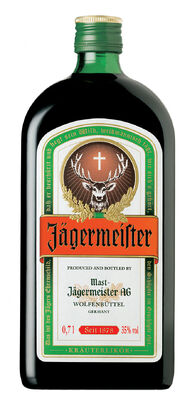
Jägermeister is a German herbal liqueur made from rum, cane sugar, beet sugar, herbs and spices.
Description[]
Flavor[]
The 70-proof drink is made from 56 different herbs, blossoms and roots as well as fruits from the most varied countries of the world for example cinnamon-bark from Ceylon, bitter orange skins from Australia, santal from East India, ginger roots from southern Asia, and works well as a digestif.
History and origin[]
Jagermeister is a drink that’s German in origin. In 1934, the term "Jagermeister" was used to describe the country’s gamekeepers and senior foresters. It wasn’t until a year later, in 1935, that the liqueur was introduced to the public. And, by then, Germans were already familiar with the name that we still know today.
The liqueur was given the name Jagermeister because its inventor, Curt Mast, was an avid hunter. Since Jager means hunter and Meister means master, the name can literally be translated to mean hunt master or Hunt Master. In Germany today, there is a position called Jagermeister which is an employee of the district’s hunting authorities, responsible for the region’s hunting regulations.
When Jagermeister first found its way into the beverage market, it wasn’t marketed as a tasty liqueur that is perfect for drinking as a shot. Instead, it was marketed as being a medicinal product that could work well for helping a variety of health issues, such as digestive problems and coughing.
To take it a step further away from being the drink it is today, it was even used during WWII as an anesthetic in the field.
There has even been some controversy surrounding the liqueur. One urban legend has stated that the liquid contains elk or deer blood. However, that is a legend that is not true.
Today, it is still used in Germany as a digestif. Residents there even jokingly refer to the beverage as Leberkleister, which translates to mean liver glue. As if there weren’t enough uses for Jagermeister, it can also commonly be seen in insect traps set throughout a home because wasps and flies are drawn to its flavor. When creating Jagermeister, its main ingredients include beet sugar, cane sugar, alcohol, spices, and herbs. It is very similar to the stomach bitter used in Europe, but the sugars used to create it give it a sweeter taste than those often seen in European countries, such as Hungary’s Unicum and Denmark’s Gammel Dansk. Some consider the liqueur to be a Bitter. Technically, however, the term can only be applied to a beverage that is actually bitter in taste. Jagermeister is not bitter, its taste is actually tends to lean more to the semi-sweet side. So, when referring to Jagermeister, it would be more correct to call it a Halbbitter, which means half bitter.
Today, Jagermeister is Germany’s market leader. Not only is the liqueur popular for drinking, its name is also quite well known for being associated with sponsorship. Jagermeister is known for sponsoring various teams in the motorsport industry. The brand’s insignia can be seen emblazoned across several cars throughout the European racing circuit. Not only can Jagermeister be seen in racing, it is also a sponsor of German soccer, with its name being seen in advertisements in several German soccer stadiums.
The United States has also seen Jagermeister’s sponsorship, especially when it comes music. The brand even has its own podcast.[1]
Label[]
The old German writing around the Jagermeister label translates to “It is the hunter’s honor that he protects and preserves his game, hunts sportsmanlike, honors the Creator in his creatures” For centuries, St. Hubertus has been the patron saint of hunters. According to the legend, in his youth, Hubert was a wild and unrestrained hunter, without responsibility towards the creatures that he hunted and captivated by the drive to kill. Even on the holy day of Sunday, he set off into the forest with his dog and weapon and cared little about the day of the Lord. Until one holy day, emerging from the dark woods, a large white deer carrying an illuminated cross between his antlers confronted him. From the moment of his vision, he devoted himself to good works under the banner of the antlered stag. He died in 727 AD, and centuries later he was venerated as a patron saint. It is from this story’s inspiration that the Jagermeister trademark derives.
